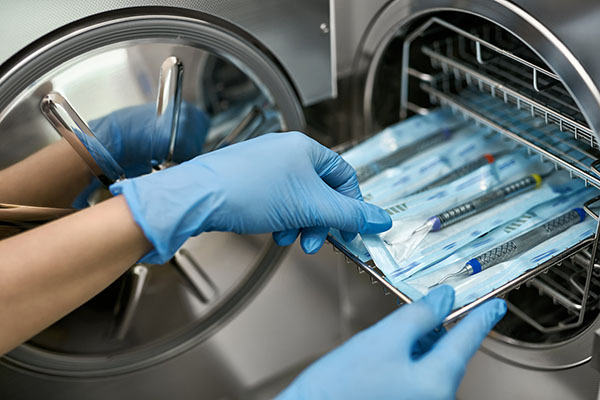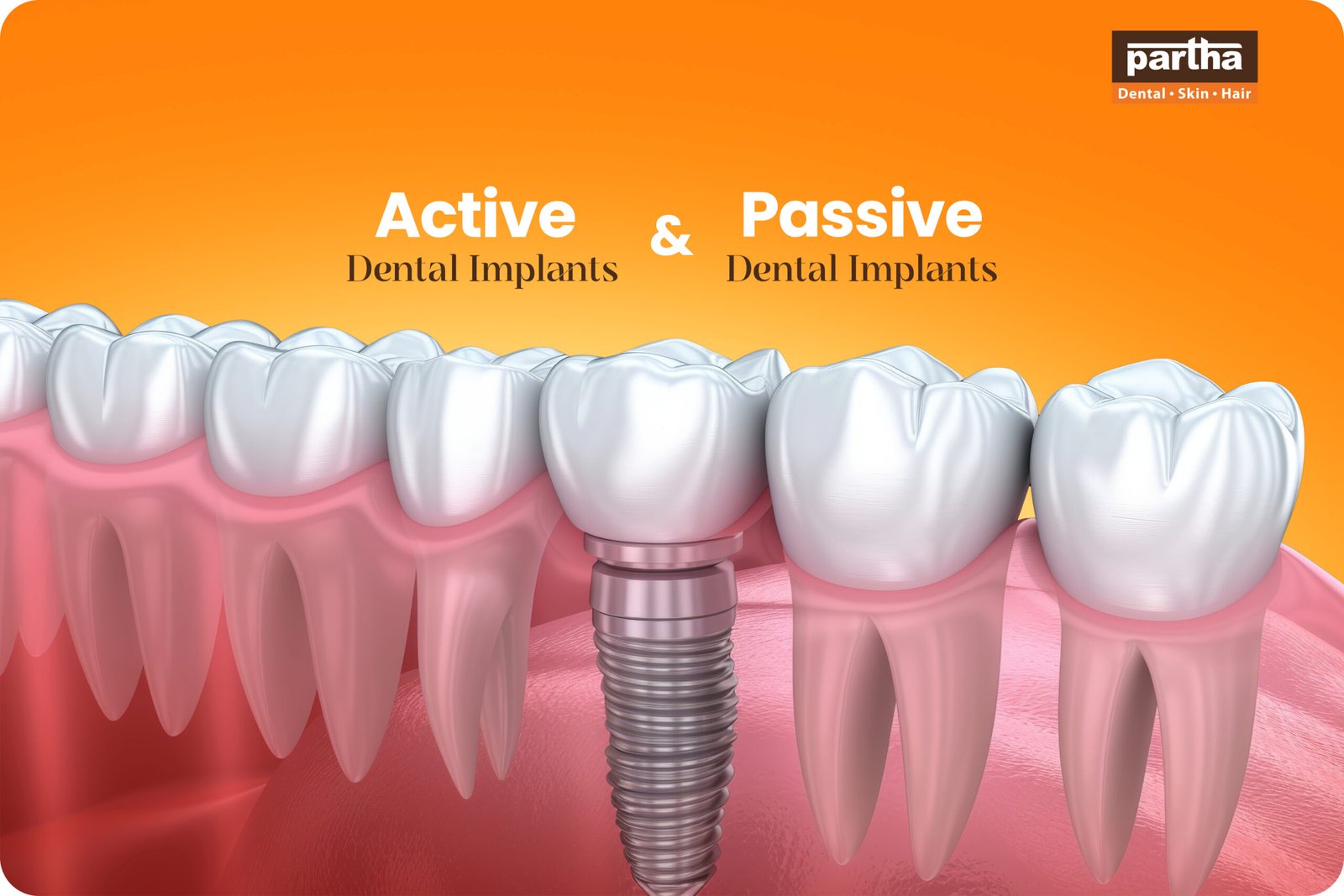Table of Contents
If you’ve spent time digging into dental implants, you likely ran into this term – active or passive types.
While it sounds technical, the idea’s pretty straightforward once broken down.
Nope, this isn’t about implants stretching into yoga poses or lounging around. Still… picturing them bent over like that?
In real life, “active” or “not active” just shows how the implant sticks to your jaw. Still, that detail might affect recovery speed, feel, firmness, and also lasting results.
Alright, here’s the deal – Partha Dental way: light, no-fuss, nothing like those dull manuals that make eyes glaze over.
1. What Are Active Dental Implants?
Active implants? They’re the buddy who arrives ahead of time, lends a hand moving stuff around, yet manages to stay pumped enough to hit dinner later.
Their shape helps them dig into bone right away when put in place – sharp ridges grab hold fast.
So they stick better from the start because the edges bite in quickly.
- High primary stability.
- Faster healing.
- Better help where bones are weaker.
- Fine for quick setup.
Imagine these as tiny anchors that grab hold and run things on their own.
2. What Are Passive Dental Implants?
Passive implants? Think of a laid-back buddy who doesn’t push back.
Not trying to grab hold tight – just hanging out quietly.
Over time, the bone wraps around them without force. No rush, no pressure.
They depend mostly on osseointegration – basically, how bone naturally bonds – to hold things in place gradually.
Passive implants offer:
- Gentle placement.
- Excellent long-term stability.
- Favored where bones are tightly packed.
- Most often seen in standard implant methods.
3. Active vs Passive Dental Implants: The Core Difference
It’s showtime now. Ring ringring!
Active implants:
- Grab onto the bone like Velcro.
- Perfect when dealing with tender or less compact bones.
- Let it load right away or sooner.
- Build better balance from the start.
Passive implants:
- More relaxed fit.
- Count on your body’s own ability to repair bone.
- Most often applied if the bone’s thick.
- Prefect when you want things to load later.
Choosing between active or passive dental implants? The key thing to think about is this:
“What does your bone need?”
4. Types of Dental Implants – Where Do Active and Passive Fit?
Before picking the right implant for your teeth, take a quick peek at the main kinds used around the world.
That’s because – just like people – they each have their own quirks and looks.
Endosteal Implants (Most Common)
These sit right into the jawbone – some work on their own, others don’t. At Partha Dental, they’re top choice, plus get suggested more.
Subperiosteal Implants
They rest right above the jawbone, under the gums. Not common now – still picked if there’s not enough bone and adding more isn’t doable.
These go right into the zygoma – bypassing the jaw entirely. Quite lengthy, solid build, perfect when bone’s really worn down.
Mini Dental Implants
Much skinnier models – often keep dentures steady. Typically don’t do much on their own.
Pterygoid and Basal Implants
When there’s not much bone up top, implants go in differently. That’s why they sometimes rely on special screw-like designs – since the area might be tough to work with.
Book your FREE consultationNow we’ve seen every type of implant – so here’s the big answer.
5. Which Dental Implants Are Best?
Right – right after folks search “Will implants sting?” or “Can I have biryani post-implant?” Sure, just not straight away.
The question about the top dental implants doesn’t have a single fix for everyone. It’s kind of like wondering, “What’s the perfect shoe?”
Depends – jogging? Getting married soon? Hiking through trails? Or gliding on skates?
The top pick for an implant also relies on factors like:
- Bone density
- Gum health
- Where the tooth isn’t there anymore
- Medical history
- Budget
- When it’s about getting teeth in a single day.
- Your long-term expectations
When Active Dental Implants Are Best:
- Where bones feel tender
- When you’re after quick loading
- Right from the start, staying steady matters most
- When implants go into tough spots – say, near the pterygoid area
When Passive Dental Implants Are Best:
- With strong bones
- When slow recovery works just fine
- If you don’t need super harsh cuts
- When lasting power matters most
At Partha Dental, we pick implants that fit how your bone acts – because yep, bones have quirks.
One might chill out easy, another stands stiff, some feel mushy like a squished cushion, while others hit hard, just like those no-nonsense cops.
Active vs Passive Dental Implants: Which One Heals Faster?
Need a quick reply?
Active implants tend to recover more quickly.
Built to hold the bone tight right away, so you get:
- Early loading
- Faster recovery
- Less micromovement
Passive implants move at their own pace – less speed, yet steady.
Relying on the body’s slow bone repair feels just like letting dosa mix ferment slowly.
Sure, progress shows up only if you give it space to grow.
Active Dental Implants Cost – Are They More Expensive?
Here’s the math – won’t hurt your cash flow.
Active dental implants cost tends to be slightly higher because:
- The layout’s a step ahead
- The threading – plus the way it’s built – feels sharper somehow
- These are usually for tougher situations
- They let you load right away – though that might raise the total price
At Partha Dental, the pricing depends on:
- The kind of implant setup
- The bone condition
Does the procedure require adding new bone material?
What number of implants do you require?
Still, relax – there’s no push for fancy solutions when basic ones work just fine for you. Zero pressure, zero tricks. Choices rooted in proof, not profit.
How We Decide Between Active vs Passive Dental Implants at Partha Dental
Picking an implant? Not the same as deciding on tea instead of coffee. More like finding a good match – timing, fit, vibe – all have to line up.
This is how we check things out:
Bone Density Scan
Your bone picks if you’re into active implants or just go with passive ones instead
Tooth Location
Front teeth usually need quick support → so active works better.
Molars might get along okay without active effort.
Your Timeline
Want teeth quick? Action brings success.
Sure if you’re okay with hanging on a bit? Being chill works just fine.
Medical Considerations
Certain situations need extra steadiness at first.
Your Comfort Level
Some people like how steady passive implants feel. Yet others go for quicker outcomes.
We mix science with tech, then add real-world know-how – so we find exactly what fits your needs.
Myths about Active vs Passive Dental Implants.
Myth 1: Active implants aren’t necessarily superior.
Nope. Soft bone? Sure thing. Thick bone? Maybe not.
Myth 2: Passive implants are outdated.
Not true. Lots of patients keep using them anyway.
Myth 3: Getting active implants feels worse when they’re put in.
Still wrong. Each procedure uses numbing medicine, so your bone won’t hurt at all.
Myth 4: Passive implants need way too long to recover.
Overstated. Because they simply move at your bone’s own rhythm instead.
Active vs Passive Dental Implants – So, Which One Should You Choose?
Active implants mean quick results, steady performance – ideal when bone quality’s low.
Passive implants work softly – dependable performance when bone’s tough. Not aggressive; fits well where density matters.
At Partha Dental, our implant experts check your jawbone, how you chew, health background, plus what you want to achieve before picking the best fit. Whether your bone’s into action or just likes to take it slow, we’ll find exactly what works. Call us now 04041420000 to book an appointment.
6. Frequently asked questions
One gives better hold at first. Over time, both work about the same if set up right.
Nope. Success levels stay about the same. What really matters is fitting the implant right to your bone structure.
The label, how tricky the layout is, if fast start-up matters, also the situation’s toughness.
You could go solo – though honestly, we’ve got your back on this. Picture picking lenses for your eyes: why wing it when someone skilled can guide you.
Some implants hold tighter in weak bone, yet ditching cigarettes boosts healing way more than picking a certain screw.
Nah, yet the fresh ones bring better looks plus faster results. Read more.
Dental Questions? We’re here to help!
Disclaimer:
The prices mentioned in this blog are indicative and may vary based on the severity of the condition, technology used, and materials suggested by the Dentist. They are accurate as of the date of publishing and subject to change as per clinic policy. Third-party or AI-generated estimates may not reflect actual clinic pricing. For accurate costs, please visit your nearest Partha Dental clinic.




